In 2019, Bloomberg ran an article about the increasing preponderance—and necessity—for more battery storage. While the nuances of that article may be outdated at that time, the idea that “it can’t happen without battery storage” remains as salient today as it was four years ago. Along with the proliferation of distributed energy resources (DER) like rooftop photovoltaic solar continues to gain market value and hold public interest, battery storage is an essential component in optimizing the potential of renewable energy; without battery storage, a lot of generated energy would be lost. The good news? The battery market is up, signaling both consumer commitment and potential opportunities for enterprising utilities.
The Battery Storage of Today & Tomorrow
Research into battery storage technologies continues to innovate, again illustrating the capital investments driving the industry: people want battery storage and they want it now. This research has yielded a variety of battery types, including compressed air energy storage, mechanical gravity energy storage, and flow batteries to name a few of the more common current design types. New technologies include mobile utility-scale batteries, innovations in lithium alternative batteries, and more.
As decarbonization efforts continue, these battery storage types will become increasingly useful in enhancing grid reliability while lowering high energy costs. Beyond that, batteries are potential grid assets that—with the right distributed energy resource management system (DERMS)—can be used to minimize the strain on the grid during peak times of usage.
Battery Storage & Decarbonization
The two key hurdles to moving away from fossil fuel dependence to a renewable energy future rely on harvesting power during the day that can be stored and then used later during peak energy demand and making sure that there’s enough power available even on calm, cloudy days. Storage remains one of the three critical components of the carbon-free triad: renewable energy sources, low-cost storage, and demand-side management.
How Green Mountain Power Sees the Potential of Battery Storage
In 2019, Mary Powell, the former CEO of Green Mountain Power (a Virtual Peaker customer and partner), had this to say on the current capabilities and growth potential for battery storage. “We think storage can be the leapfrog technology that’s really needed in a world that’s focused on dramatic climate change,” said Powell. “It’s the killer app in a vision to move away from bulk delivery systems to a community, home, and business-based energy system.”
But innovation in storage is happening across all parts of the energy system. When we first wrote about this, there were several interesting stories about new storage technologies receiving substantial investment:
- Form Energy, which has been focused on developing a long-duration storage technology just raised a $40 million Series B investment round.
- Gravity-based storage company Energy Vault just raised a series B of their own at $110 million. Highly recommend visiting their website for the video alone!
While these companies represent developments at a larger grid scale, they are one part of a broader (and exciting) energy revolution. Already, breakthroughs in energy storage are adding small-scale homes to the list of grid-connected energy providers, adding value to homeowners and utility providers alike.
Utility Battery Programs
As you can see, energy storage isn’t just a trending topic, but an integral step in the transition to increased renewable energy access. Utilities can utilize batteries through a variety of potential applications including:
- Managed Charging Programs – Managed charging programs are a demand flexibility strategy that helps minimize EV charging during peak periods of usage, saving money on high energy costs, while strengthening grid resiliency.
- V2G Charging – Like managed charging programs, V2G charging is a reciprocal charging strategy that allows utilities access to the stored power dormant in charging vehicles during peak times of usage, replacing it later at off-peak hours.
- Virtual Power Plants – More than just a trendy buzzword, virtual power plants use existing DER assets—including battery storage—as an aggregate, community-powered renewable energy solution, again offering the potential to lower energy spending while enhancing energy security.
Additionally, emerging functionality like EV telematics provides valuable data analysis on EV batteries, allowing utility program managers to make an informed choice on when to run their programs without causing a disruption to your customers.
Battery Storage Conclusion
The more batteries are in our communities, the faster the transition to carbon-neutral alternatives. Fortunately, battery storage technologies continue to show promise in peak shaving, as part of a virtual power plant system, and more; the potential is fantastic! As more batteries enter our respective communities, does your utility have what it takes to harness the potential of increased battery storage? If not, the time to prepare for the grid of tomorrow is now, and we’re here to help.
Article originally published on August 26, 2019, with updates on February 24, 2023.






